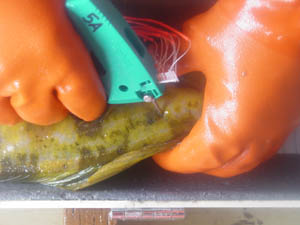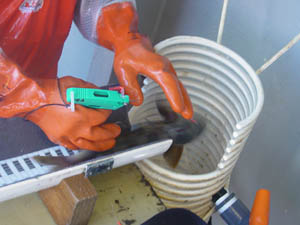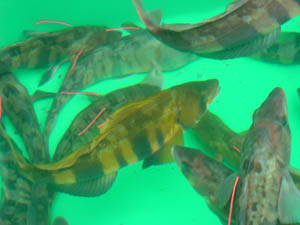|
STATUS OF STOCKS AND MULTISPECIES ASSESSMENT PROGRAM:
| |

A scientist tags an Atka mackerel during the Atka mackerel tag research cruise. The tags are inserted
into the dorsal muscle with short needles via tagging guns. (Photos by Ivonne Ortiz.)
|
Atka Mackerel Tagging
The fishing vessel Pacific Explorer was chartered from 12-26 July 2003
for tag and release studies of Atka mackerel in the Amchitka Island area
of the Aleutian Islands, Alaska. The cruise represents the fourth consecutive
year of work by the AFSC on Atka mackerel in the Aleutian Islands and the
first year of work in the Amchitka Island area. During the years 1999-2002,
Atka mackerel were tagged and released in Seguam Pass; during the year
2002 Atka mackerel were also released in the Tanaga Pass area. The objective
of these studies is to determine the efficacy of trawl exclusion zones
as a management tool to maintain prey abundance and availability for Steller
sea lions at local scales. Trawl exclusion zones were established around
sea lion rookeries as a precautionary measure to protect critical sea lion
habitat, including local populations of prey such as Atka mackerel. Localized
fishing may affect Atka mackerel abundance and distribution near sea lion
rookeries. The purpose of the Pacific Explorer cruise in July 2003 was
to tag and release Atka mackerel inside and outside the trawl exclusion
zones in the Amchitka Island area.
|

An Atka mackerel recently tagged is ready to be released into the waters at Amchitka Island in the Aleutians.
Fish tolerate tagging procedures well with a survival rate of over 95%.
|
|
Fish tagged throughout the areas open and closed to the fishery from the
years 1999 to 2003 are being recovered by the fishery in the areas outside
the trawl exclusion zones. Recoveries of tagged fish in the closed areas
are provided by chartered tag recovery cruises. NMFS will estimate movement
and abundance of Atka mackerel in areas of Seguam Pass and Amchitka Island
open and closed to the fishery.
A feasibility study was conducted in 1999 at Seguam Pass. In the years
2000-2002 approximately 37,000 tagged fish were released in the Seguam
Pass area. In 2002 another 14,250 tagged fish were released in the Tanaga
Pass area. In addition to T-bar tags, approximately 400 Atka mackerel
were released with electronic archival tags (200 in Seguam Pass and 200
in Tanaga Pass). Those tags record depth and time continuously.
During the 2003 tag release cruise aboard the Pacific Explorer 14,596 fish
were tagged and released in the Amchitka Island area; 8,906 fish were released
inside the trawl exclusion zones, and 5,690 fish were released in the areas
open to fishing. Ten tagged fish were randomly selected from every haul
and placed in tanks to assess mortality rate following capture and were
held for at least 48 hours. Nine experiments were conducted over the course
of the cruise. Of the 126 fish participating in the experiments, only
1 died, for a mortality rate of 0.08%.
| |

A tagged Atka mackerel is released through the 'slide for life', an 18-inch fish hose with flowing water that
transports the fish from deck into the water.
|
In addition to tagging and releasing Atka mackerel, AFSC scientists collected
length frequency data and took biological samples that will provide information
on age, growth, reproductive condition and diet. Otoliths, stomachs and
gonads were collected from 5 males and 5 females from every successful
haul for a total of 200 fish. Additional to the collection of gonads,
maturity stages of fish collected for length frequency data were determined
by visual inspection of the gonads. Approximately 1,500 fish were recorded
as one of six stages of females or four stages of males.
AFSC scientists also collected physical oceanographic data with the goal
of examining the water column characteristics of Atka mackerel habitat.
Continuous temperature and salinity data were collected with a Seabird
SBE45 plumbed to receive water from the same source as the tanks. Fluorescence
was measured continuously with a Turner Designs SCUFA fluorometer, plumbed
to receive water from the same source as the tanks. Temperature-depth
data were also collected with a microbathythermograph (MBT) mounted on the net.
|

Tagged fish are held in tanks on board the Pacific Explorer. This is part of the survival rate experiment
that examines how fish survive tagging procedures. Fish are generally held in tanks for 1-3 days.
|
|
In previous years AFSC scientists have been exploring Atka mackerel spawning
grounds with cameras or divers. For the first time during a tag and release
cruise, actual underwater footage of Atka mackerel habitat and spawning
males was recorded. A drop camera was deployed off a 16 foot Zodiak and
from the vessel to examine Atka mackerel spawning grounds nearshore and
in shallow reef areas around the island passes. The camera was deployed
mostly in depths ranging from 5 to 50 fathoms in the vicinity of Amchitka,
Seguam, Amlia, and Umnak Island and their corresponding passes. Spawning
Atka mackerel were found in high current areas in depths from 15 to 50
fathoms. Video footage and corresponding GPS locations of fish were recorded.
Additionally, different types of specimens were collected for special projects
at the request of other NOAA scientists. Fin clips from 200 Atka mackerel
and from 50 Pacific cod were collected for genetic analysis. Full stomachs
from nine Atka mackerel were collected for a study of the feasibility of
extracting the DNA of the prey items within. Skate specimens (one male
and one female) of a variety of species were collected for taxonomic study.
Whole Atka mackerel, walleye pollock and Pacific cod (10 males and 10
females) were frozen for proximate analysis of lipid, protein, water and
ash content. A number of Atka mackerel, rockfish and flatfish (10 to 20)
were collected to be used as specimens for Observer Program training.
By Susanne McDermott and Libby Logerwell.

|
 |
quarterly July-Sept 2003 sidebar
AFSC Quarterly
Research Reports
July-Sept 2003
Contents
Feature
Auke Bay Lab
National Marine
Mammal Lab
RACE Division
REFM Division
Quarterly Index
Quarterly Home
|

